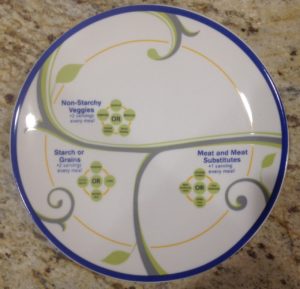Ask Mr. Pedometer and Friends…
Q: Mr. Pedometer, it’s January 2019 and I know I need to make some changes in my life to get healthy this year. I just don’t know where to start. Do you have any suggestions?
A: Since most of our health changes have to do with nutrition and exercise, start with this great article by Shereen Lehman, MS, found on the Very Well Fit website. Go through the questionnaire and be honest with yourself. Then instead of trying to change everything at once, pick one thing to change, i.e. decide to get up a half hour earlier each morning and go for a walk before diving into your day. Once you have established one change, go on to another one. Change 1 Thing at a time so that you don’t get overwhelmed and give up.
See the “Change 1 Thing” article below for the steps that will help you to make changes more possible.
10 Steps to a Healthier New Year
1. Take a look at what your diet and health have been like for the last 12 months. Think about these questions and write down your answers in a notebook so that you can look back at them again a year from now:
- How does your weight compare with a year ago?

- Do you feel healthy and have a lot of energy or are you tired all the time?
- Do you take vitamins or other nutritional supplements?
- Do you eat at home most of the time? If so, what types of foods? Whole fresh foods, boxed foods, or TV dinners?
- Do you dine out frequently? What types of restaurants do you like and what kinds of foods do you choose?
- How physically active are you? Do you exercise regularly?
- Do you eat healthy portions, or do you stuff yourself with every meal?
- Do you smoke?
- How much alcohol do you drink each week?
It’s important to take an honest look at your health and dietary habits so you can set goals for the next year.
Set Your Goals
Do you want to lose weight? Do you want to be able to run up and down the stairs without getting winded? Do you want to reduce cholesterol or lower your blood pressure? Decide what you want to achieve over the next month, and over the next year.
One possible goal for your first month could be a resolution to take your lunch to work four days per week for each week this month instead of eating lunch in restaurants every day. Another example of a monthly goal would be to walk for 30 minutes four days per week each week this month.
Start with your statistics. Take body composition measurements and make your goals. Then write down your goals in a notebook or in the food diary you are going to create in step seven.
Determine Your Dietary Needs
Here are some ideas you might want to consider:
- Do you have high blood pressure? If so you may wish to reduce sodium in your diet by avoiding canned and packaged foods.
- Are you overweight? You need to decrease your calorie intake or increase your amount of physical exercise. You can choose a low-carb diet or a low-fat diet, just be sure to watch your calories and portion sizes.
- Do you have diabetes? If so, then you need to reduce your sugar intake.
- Do you have high cholesterol? Increase your intake of soluble fiber like the fiber found in oatmeal. It will help lower your cholesterol levels.
Reduce your intake of saturated fats and increase your intake of omega-3 fatty acids from fish, flax, walnuts, and canola oil.
Consider Dietary Supplements
A healthy diet should give you all of the vitamins and minerals you need, but many people take vitamins just to make sure. There are several formulations available, but all you need is a simple multivitamin and multi-mineral supplement. Speak with your health care provider before you take any additional supplements or if you have any health conditions.
Design Your Healthy New Diet
Here’s what you need to know to design your new diet:
- How many calories do you need to eat each day to reach your weight gain or weight loss goal?
- How do your eating patterns fit your lifestyle?
- Do you feel better with three large meals per day or five smaller meals per day?
- Will you continue to eat in restaurants often?
- What types of fruits and vegetables do you like?
A healthy diet should give you five to nine servings of fruits and vegetables per day, 25 to 38 grams of fiber per day, five or six ounces of protein per day, and a small amount of omega-3 essential fatty acids. To stick with your new diet, you’ll want to include foods you enjoy. If you love hamburgers, that’s OK. Make them at home with whole grain rolls and cut down the size of the burger patty, or use ground turkey. Add lots of lettuce, onion, and tomato. Serve your burger with a salad instead of fries.
More Tips:
- Choose crunchy raw green beans instead of chips and serve them with a little of your favorite dip.
- Replace high fat hot dogs with soy dogs.
- Choose whole grain bread and pasta instead of white bread and white pasta.
- Skip the sugary desserts and have a small dish of fresh berries with a dab of whipped cream or non-fat whipped topping, then add a sprinkling of chopped walnuts.
- Use lemon juice instead of oil for a salad dressing.
- Choose low-fat ground turkey instead of high-fat ground beef to cut back on saturated fat. (But remember to read the label—not all ground turkey is low in fat.)
- Use these tips for finding healthful foods on a restaurant menu.
Shop and Cook
- Couple cooking in kitchen
- Make a grocery list before you go shopping. Stay away from the snack food aisles and the prepackaged foods aisles when you shop. Choose fresh fruits and vegetables, whole grain breads, lean meats, fish, and legumes. Avoid foods high in saturated fats, sodium, trans-fats and sugar.
- The best cooking methods are essential for healthy nutrition, too:
- Sautéing is better than deep-frying. Frying foods adds fats and calories and doesn’t add any nutrition.
- Steam your vegetables instead of boiling them to mush. Steaming will preserve the vitamins found in the vegetables.
- When you cook your healthy meals at home, be sure to make extra to take to work or school the next day
Keep a Food Diary
If you’re serious about changing your diet, losing (or gaining) weight, and improving your health, you’ll find that keeping track of things is key to your success in a simple food and exercise diary. This will help keep you motivated and help you get back on your diet if you have a temporary setback.
Be sure to note the portion sizes and write down the calories you eat every day. Add up the number of calories per day and your total for the week. If you need to lose weight, decrease the number of calories you need to eat each week by 500. For most people, that adds up to one pound per week.
You can make your own food diary or keep track of your healthy new diet online.
Get Fit
- Join an exercise class.
- Mr. Pedometer includes getting outside in the fresh air and taking a walk.
Good nutrition is just one part of a healthy lifestyle. Another component of health and fitness is exercise. If you lead a sedentary lifestyle, you need to get out and get moving. If you want to lose weight, it is important to increase aerobic activity like walking or running. If you need to increase your strength, then you need to start resistance training such as lifting weights.
- There are health clubs, gyms, and personal trainers, as well as at-home equipment to get you fit and healthy.
- Do you smoke? If so, you’ll do yourself a favor by quitting. Smoking has been connected to many chronic diseases, plus you will save a lot of money over the next year if you quit smoking.
- How much alcohol do you drink? One drink per day has been shown to be beneficial. More than one drink per day can be detrimental to your health, however. If you find yourself drinking more than four ounces of wine, two ounces of liquor, or 12 ounces of beer each day, then you may need to decrease your consumption of alcohol
Reduce Your Stress
- Stress relief is important for your health.
Stress is detrimental to your health. Stress includes daily events like constant deadlines at work; long drive times with excess traffic; more activities than time to do them; and emotional trauma like death or divorce.
Stay Motivated
Sometimes getting started with a new healthy diet and fitness plan is the easy part. Many of us hit occasional roadblocks due to busy schedules, loss of motivation, or weight loss plateaus.
Those are the times when we feel like we do everything right, but the scale doesn’t seem to budge. When this happens, don’t give up. Think back to why you made the goal in the first place and find the inspiration you need to get back on track. Be sure to celebrate your small successes too!



